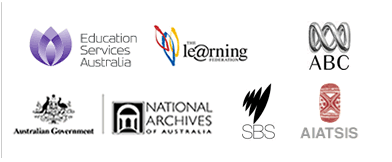Original classification rating: PG.
This clip chosen to be PG
Clip description
The girls walk into a cafe for milkshakes. They are told to drink them at the counter. Trilby (Kristina Nehm) urges her family to sit down in a booth. The white patrons taunt them with racist remarks.
Curator’s notes
This scene establishes how Trilby and her family are positioned within society, and the racism that informs this experience.
Teacher’s notes
provided by 

This clip shows the interactions between a young Indigenous girl, Trilby (Kristina Nehm), members of her family and non-Indigenous residents in a small Australian country town in the 1980s. It opens with Trilby encouraging her companions to enter a cafe where Indigenous people do not normally go. Their presence is greeted with hostility although one customer defends their right to be there. This scene is intercut with a scene in the local hospital where Trilby’s sister Noonah, a nurse, is embarrassed when her mother arrives to see her.
Educational value points
- The clip exposes racism in small-town Australia in the 1980s at the same time as challenging the potential racist assumptions of the audience. Racism is expressed openly through language as well as covertly through looks and glances in both the hospital and the cafe scenes. However, the racism of the cafe patrons, and perhaps the audience, is challenged when the male customer defends the right of Trilby and her friends to be in the cafe.
- The experience of racism is depicted clearly in the clip. The town appears to have areas that are ‘no go’ for Indigenous people and Trilby resents this. As she says, ‘there’s no law against it’ (going into the cafe) but the clip shows that unwritten laws can be even harder to fight. She refuses to drink the milkshake at the counter but by sitting down she and her companions are subjected to racist remarks designed to show them they are unwelcome and to indicate their inferior status.
- Trilby and her elder sister Noonah are depicted in the film as people attempting to negotiate two cultures. Intelligent and articulate, they aspire to succeed in a white world that despises them, and their traditional cultural practices now appear to offer no support. As the one member of the family with a job, Noonah feels obligated to support her relatives as sharing is a fundamental value in Indigenous cultures.
- The ‘whites only’ rule was applied strictly in some Australian towns in the 1960s, the setting for the novel on which the film The Fringe Dwellers (1986) was based. Charles Perkins led the Freedom Rides in 1965 to challenge this colour bar. With a group of local children he entered the Moree Baths, where Indigenous people were not allowed to go. The resulting publicity contributed to the overwhelming vote in favour of Indigenous equality in the 1967 referendum.
- The film The Fringe Dwellers was based on the novel by Nene Gare (1919–94) about white attitudes to Indigenous people that she observed while living in Geraldton, Western Australia, in the 1960s. The novel was a landmark in that it confronted readers with the situation of Indigenous people living on the outskirts of Australian towns. The film changed the story’s setting to the town of ‘Curgon’ in Queensland in the 1980s.
- The Fringe Dwellers was based on a white woman’s story and was made by white filmmakers, but it was significant in 1986 for having a cast who were almost entirely Indigenous and having Indigenous activist and poet Oodgeroo Noonuccal as an actor in, and script adviser for, the film.
- The film’s director, Bruce Beresford (1940–), returned to Australia from the USA to make The Fringe Dwellers after achieving success with such films as The Adventures of Barry McKenzie (1972) and Breaker Morant (1980), which had established his international reputation. The Fringe Dwellers received critical and international success when it was released in 1986 but gained only a lukewarm reception in Australia.
A group of Aboriginal girls stands indecisively outside a diner.
Girl 1 Trilby, come on down the other one.
Trilby No law against it, is there?
Girl 1 We got our own place.
Trilby There’s no law against it.
They enter the diner and the white patrons stop talking and stare at them.
A large overdressed Aboriginal woman searches around a hospital.
Mum Noonah! Noonah!
Noonah drags her mother outside.
Noonah Mum, how many times have I told you not to come here when I’m on duty? Matron doesn’t allow it.
Mum That’s real nice – not allowed to see me own daughter.
Noonah It’s even worse coming in Auntie Hannah’s coat.
Mum Why? I reckon it’s real flash. A bit tight underneath the sleeves there.
Noonah Mum… Mum, you’re the third person that’s come to see me wearing that coat this week.
Mum You mean they come after I told them it wasn’t allowed?
Noonah That includes you, Mum.
Mum They come to borrow money, I suppose. Just because you’ve got a job. And you give it to ‘em, too. Oh, well.
Noonah Mum, I’ve still got a few dollars.
Mum Don’t worry! I’ll borrow some from Hannah. She made enough renting out this rotten old coat.
Inside the diner, the Aboriginal girls stand at the counter waiting for their drinks.
Girl 1 Hey, look. There’s Old Skippy.
Trilby I thought he was inside for stealing chickens.
Girl 2 He told the magistrate he found them out in the bush. They couldn’t prove nothing.
Girl 1 Mum reckons he’s king of the Wirriji. At night, he can turn into a dingo.
Trilby That’s rubbish, them stories.
Girl 1 No! Dad told me about the time Skippy went up…
The waitress slams their drinks down.
Waitress Just drink ‘em at the counter, will you?
Trilby defiantly leads her friends to a vacant table. A white girl at the next table can be clearly overheard amid the general hubbub of conversation.
White girl What do you think of that?
White girl 2 Their own place must have burnt down.
White girl Thought they only drank metho.
White girl That looks like my brother’s shirt we put in the second-hand shop.
White girl Nah. I hope they disinfect their glasses then.
White girl Why do they call Aboriginals boongs? Because that’s the noise they make when they hit the roobars.
Man at counter addressing white girl You ought to be ashamed of yourself. I’m talking to you. Those kids have got as much right to be in here as anybody.
Thanks to the generosity of the rights holders, we are able to offer 'As much right as anybody' from the feature film The Fringe Dwellers as a high quality video download.
To play the downloadable video, you need QuickTime 7.0, VLC, or similar.
You must read and agree to the following terms and conditions before downloading the clip:
australianscreen is produced by the National Film and Sound Archive. By using the website you agree to comply with the terms and conditions described elsewhere on this site. The NFSA may amend the 'Conditions of Use’ from time to time without notice.
All materials on the site, including but not limited to text, video clips, audio clips, designs, logos, illustrations and still images, are protected by the Copyright Laws of Australia and international conventions.
When you access australianscreen you agree that:
- You may retrieve materials for information only.
- You may download materials for your personal use or for non-commercial educational purposes, but you must not publish them elsewhere or redistribute clips in any way.
- You may embed the clip for non-commercial educational purposes including for use on a school intranet site or a school resource catalogue.
- The National Film and Sound Archive’s permission must be sought to amend any information in the materials, unless otherwise stated in notices throughout the Site.
All other rights reserved.
ANY UNAUTHORISED USE OF MATERIAL ON THIS SITE MAY RESULT IN CIVIL AND CRIMINAL LIABILITY.
This clip is available in the following configurations:
| File name | Size | Quality | Suitability |
|
fringedw1_pr.mp4
|
Large: 22.1MB |
High |
Optimised for full-screen display on a fast computer. |
|
fringedw1_bb.mp4
|
Medium: 10.4MB |
Medium |
Can be displayed full screen. Also suitable for video iPods. |
Right-click on the links above to download video files to your computer.
Thanks to the generosity of the rights holders, we are able to offer this clip in an embeddable format for personal or non-commercial educational use in full form on your own website or your own blog.
You must read and agree to the following terms and conditions before embedding the clip:
australianscreen is produced by the National Film and Sound Archive. By using the website you agree to comply with the terms and conditions described elsewhere on this site. The NFSA may amend the 'Conditions of Use’ from time to time without notice.
All materials on the site, including but not limited to text, video clips, audio clips, designs, logos, illustrations and still images, are protected by the Copyright Laws of Australia and international conventions.
When you access australianscreen you agree that:
- You may retrieve materials for information only.
- You may download materials for your personal use or for non-commercial educational purposes, but you must not publish them elsewhere or redistribute clips in any way.
- You may embed the clip for non-commercial educational purposes including for use on a school intranet site or a school resource catalogue.
- The National Film and Sound Archive’s permission must be sought to amend any information in the materials, unless otherwise stated in notices throughout the Site.
All other rights reserved.
ANY UNAUTHORISED USE OF MATERIAL ON THIS SITE MAY RESULT IN CIVIL AND CRIMINAL LIABILITY.
Copy and paste the following code into your own web page to embed this clip:




 Share
Share





